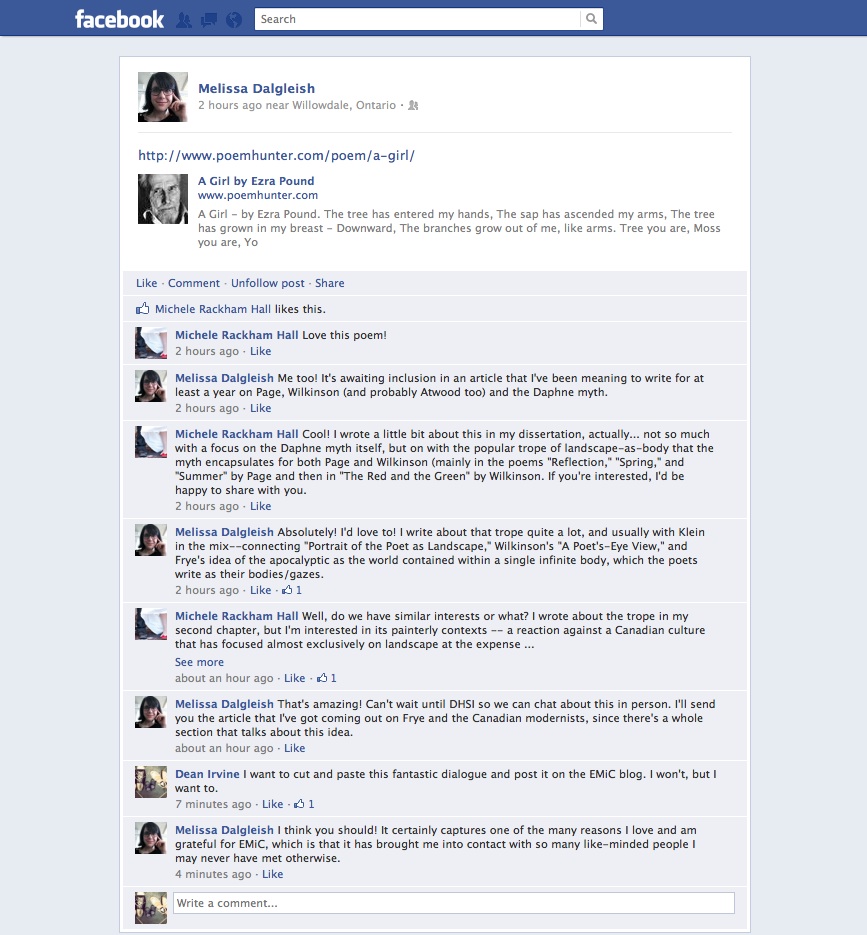Archives
Archive for March, 2012
March 30, 2012
Facebook Metamorphoses
March 21, 2012
EMiC Spring Bulletin 2012
2012 has been a very eventful time for the EMiC community. To keep everyone informed about some of the exciting advancements and contributions made by our project members this year, we have put together a Spring Bulletin full of updates, upcoming events and recent publications.
We are taking this as an opportunity to introduce some of our new co-applicants and graduate fellows, as well as to highlight on-going research and new publications. Enjoy!
March 20, 2012
Audrey Alexandra Brown: A Scholarly Exhibit
This semester I’ve been taking a class in the digital humanities with Jentery Sayers and am now beginning work on a larger project to digitize, annotate and present the photographs, newspaper articles and audio in the Audrey Alexandra Brown fonds at UVic. Under the supervision of Professors Ross and Sayers, and with the help of Chris Petter and John Frederick in UVic Special Collections, I hope to provide a data model, sample images and audio, and a narrative, which will delineate the ways in which an increasing reliance on these media to market Brown’s work undermined her supporters’ hope of establishing Brown as one of Canada’s Romantic poets. As such, her example may speak to larger questions concerning the interplay between East/West divisions and the impact of modern media on the marketing of Canadian poetry in the 1930s.
My project on Brown will take the form of a scholarly exhibit. I plan to scan archival material from the Audrey Alexandra Brown fonds in The Special Collections Unit to .jpeg form. The media will be housed on the UVic server, and I will back up the material on an external hard drive. To display and annotate the digitized material, I plan to use Scalar, a platform which we are piloting in the DH class. Embedded media will include the scanned images of selected photographs and poems published in various newspapers. I plan to use Dublin Core to ensure that each image is well documented so that scholars will be able to cite the material in future work. I also plan to provide an .xls spreadsheet for those interested in finding the original materials modeled on the Deena Larsen Finding Aid. The fields will include the title, description, date, author, source and file number, type, format, and rights for each image. The narration will comment on how increased marketing through the different media influenced reception of Brown’s poetry.
Future work on the exhibit could follow the trajectory of Brown’s later work, and might focus on how modernity impacted her writing style and later reception in academic circles. Since Brown’s work has suffered as a result of what Dean Irvine calls ‘literary-historical amnesia,’ further examination of the archival material might suggest to what extent shifts in media focus accounted for this dismissal.
Many questions have arisen as I have delineated this project and I look forward to all thoughts and suggestions:
1) How might a 1930s readership have encountered this media differently from readers today, and how can my model draw attention to these differences? Can I in any way reproduce some of the ways a 1930s audience might have encountered the media? How can my model best represent the overlap between materials?
2) How can I build a model that will allow others (librarians, other scholars and historians) to expand upon this work?
3) How do I best draw attention to the process of digitization as a transformation of the archival experience?
March 15, 2012
The Theory of the Modernist Versions Project
The aim of the project is to build an integrated online environment for collating and editing modernist texts that exist in multiple versions. The task here is much more than simply to allow comparison of texts to identify where variations occur. Instead, it is to facilitate new interpretive possibilities. That is, out of the collation of text A and text B we will generate a set of variants, that can stand as text C. We want to read text C to see what it can tell us about the evolution of a given novel, say, and then to link those changes into the social, political, economic, and cultural contexts that produce them. The theoretical issues that arise concern what counts as a text and how we can read the third possible text — the C text — that emerges out of the incompatibility between text A and text B. The aim is to read the gap between one version and the next, following Derrida’s imperative to attend to difference itself as the source of meaning rather than presuming that it is a merely negative product of the non-coincidence of two entities: text A and text B. Given modernism’s own fascination with radical breaks, discontinuities, and making things new, the theory behind our approach to textual variation is in many ways deeply modernist itself. Following the lead of such writers as Conrad, Forster, and Joyce, and the ways in which their innovations in narrative informed much of later twentieth-century theory, the Modernist Versions Project concerns itself with what gaps, silences, and difference itself can tell us. It does not pursue the holistic text of the genetic edition, nor the definitive edition of the “corrected text,” but rather the trace of what has been erased, of erasure itself, as the most productive point of meaning. In doing so, we hope to be able to restore to our understanding of modernism a key element of its production, an aspect which modernism itself elided, but which remains central to understanding it as fully as possible.
